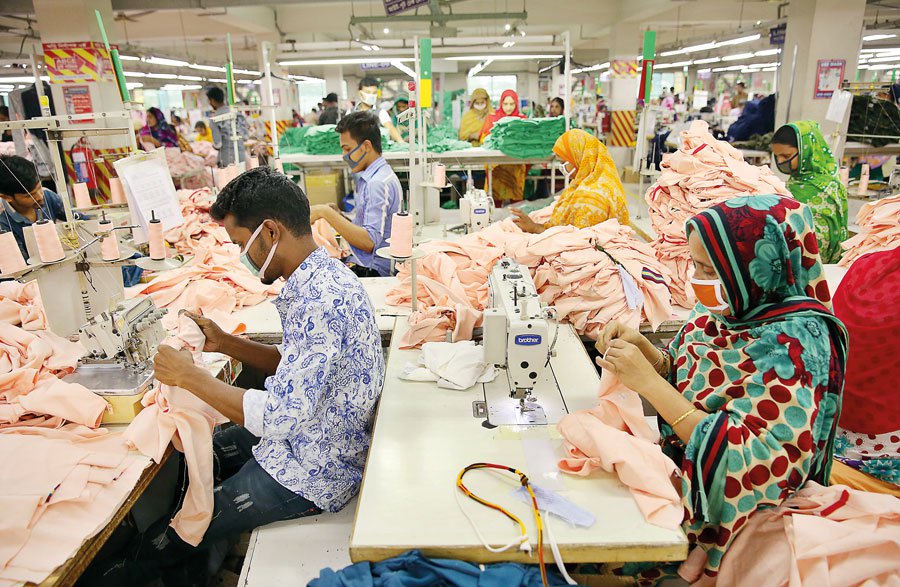Published in Dhaka Tribune on June 20, 2018

A whopping $33.5 billion is expected to come from the RMG sector. The second largest target is set for leather and leather goods at just $1.13 billion
The government plans to set a $40 billion goods export target with a 7.14% growth for fiscal year 2018-19, riding largely on the apparel industry’s success, the largest contributor to overall export earnings.
The Export Promotion Bureau (EPB) sent a proposal to the Commerce Ministry for consideration on Tuesday. After a review of the proposal, Commerce Minister Tofail Ahmed, will formally announce the export target within a week or two.
In the proposal, the EPB recommended an export target of $40 billion with 7.14% growth. The projected export earnings target is $2.5 billion higher than the outgoing fiscal year’s export target of $37.5 billion.
Of the total amount, $33.5 billion is expected to come from the garments sector. The second largest target is set for leather and leather goods at $1.13 billion.
In a meeting with export industry stakeholders on June 12, the EPB discussed the export target and heard opinions about industrial capacity.
In July-May of the current fiscal year, Bangladesh earned $33.72 billion against a target of $37.5 billion.
In setting the export target, the world economic outlook, policy changes at important export destinations, stakeholder feedback, supply chain capacity, change in exchange rates, and global business trends were taken into consideration.
 ‘It should be higher’
‘It should be higher’
“Over 82% of our export earnings come from the apparel sector. Bangladesh has enough capacity to meet the export target. We have the confidence of global retailers. But manufacturers are losing their competitive edge due to a rise in production costs,” Exporters Association of Bangladesh (EAB) president Abdus Salam Murshedy told the Dhaka Tribune.
In the proposed budget for FY19, beginning July 2018, “the government has increased corporate tax to 15%, while the tax-at-source returned to 1% from 0.70%. This will have an adverse impact on investment as well as production cost,” said Salam, a former BGMEA president.
If the government reduces the corporate tax and brings down tax-at-source to the previous level to increase competitiveness, Bangladesh will be able to reach the target, said Salam.
On the flip side, experts are saying the target, though higher than that of the previous year’s, is not in line with the development goals of the government.
“This export growth target, which is below 10% and it has been contracted, is unambitious. Our development strategy is driven by exports, but the GDP to export ratio has been falling. What does that signal?” said Policy Research Institute (PRI) Executive Director, Ahsan H Mansur.
“In attaining development goals as well as the GDP target, the export target should be much more ambitious,” he said.
“Present policy towards export-oriented industries, rate of target achievement, and performance is disappointing. This is because of lack of proper policy support to export oriented industries,” said Ahsan.
 ‘Balance needed’
‘Balance needed’
Export business leaders say they want a comprehensive and balanced export policy to achieve the export target.
“There is a lack of coordination between concerned ministries in setting the export target. The government is not taking necessary steps to remove export barriers,” Md Jashim Uddin, president of Bangladesh Plastic Goods Manufacturers and Exporters Association (BPGMEA), told the Dhaka Tribune.
The government has offered incentives to promote plastic exports but exporters are yet to enjoy the benefits. Due to lack of proper implementation, government incentives and policy support fail to reach the target,” Jasim said.
“We need policy continuity and equal treatment in terms of government incentives to provide space for emerging export industries to grow. If we can ensure this, it will help diversify the export basket,” said Jasim.
In the proposed budget, the government offered 15% corporate tax for the RMG sector while other export-oriented sectors are to pay 35% corporate tax.
To achieve the export target, the government should prioritize the emerging sector and take measures to expand the export basket, according to business people.
An exporter who is in the IT industry said Bangladesh’s export is dominated by the apparel sector, which contributes over 82% to total export earnings.
“This is not a good development strategy. If the sector fails or falls into trouble, the whole economy will suffer,” he said.
“The apparel sector always enjoys the highest government benefits due to their strong lobby, which discourages others and creates an unfair situation,” he said.
Bangladesh needs to concentrate on emerging sectors such as pharmaceuticals, information technology, jute diversified goods, plastic goods, and the leather sector, he added.
 CPD RMG Study Stitching a better future for Bangladesh
CPD RMG Study Stitching a better future for Bangladesh



